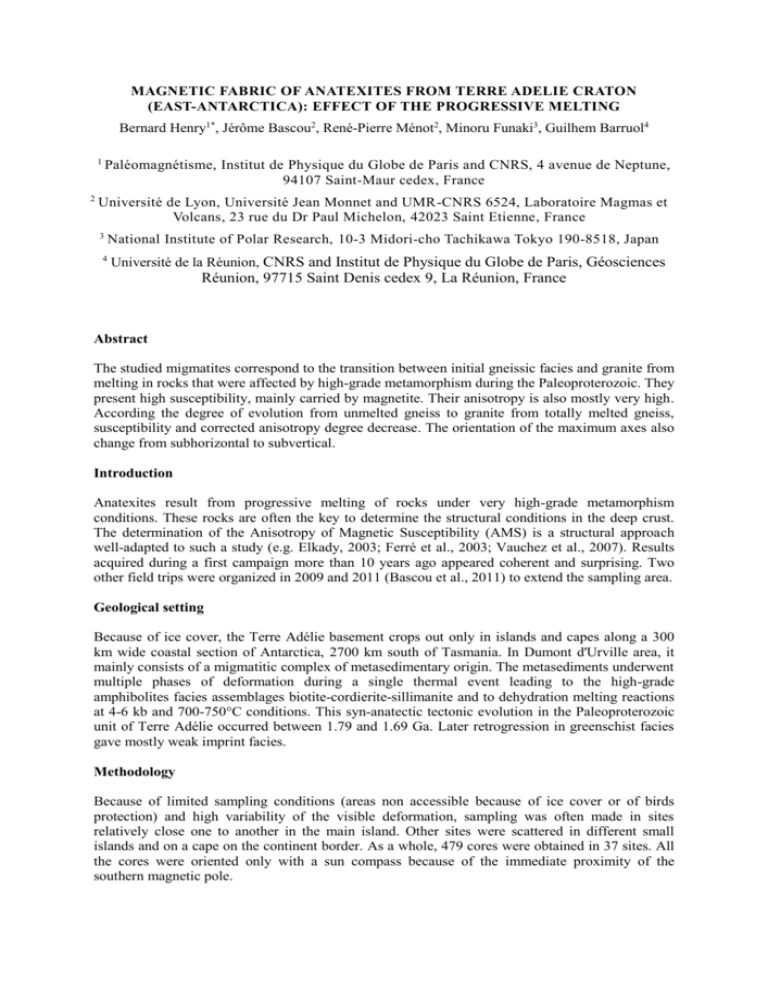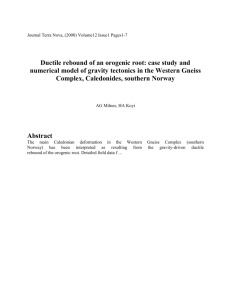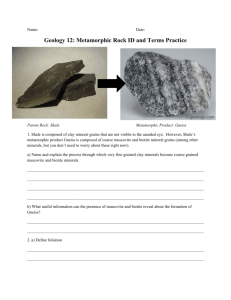2 - Université Jean Monnet
advertisement

MAGNETIC FABRIC OF ANATEXITES FROM TERRE ADELIE CRATON (EAST-ANTARCTICA): EFFECT OF THE PROGRESSIVE MELTING Bernard Henry1*, Jérôme Bascou2, René-Pierre Ménot2, Minoru Funaki3, Guilhem Barruol4 1 2 Paléomagnétisme, Institut de Physique du Globe de Paris and CNRS, 4 avenue de Neptune, 94107 Saint-Maur cedex, France Université de Lyon, Université Jean Monnet and UMR-CNRS 6524, Laboratoire Magmas et Volcans, 23 rue du Dr Paul Michelon, 42023 Saint Etienne, France 3 4 National Institute of Polar Research, 10-3 Midori-cho Tachikawa Tokyo 190-8518, Japan Université de la Réunion, CNRS and Institut de Physique du Globe de Paris, Géosciences Réunion, 97715 Saint Denis cedex 9, La Réunion, France Abstract The studied migmatites correspond to the transition between initial gneissic facies and granite from melting in rocks that were affected by high-grade metamorphism during the Paleoproterozoic. They present high susceptibility, mainly carried by magnetite. Their anisotropy is also mostly very high. According the degree of evolution from unmelted gneiss to granite from totally melted gneiss, susceptibility and corrected anisotropy degree decrease. The orientation of the maximum axes also change from subhorizontal to subvertical. Introduction Anatexites result from progressive melting of rocks under very high-grade metamorphism conditions. These rocks are often the key to determine the structural conditions in the deep crust. The determination of the Anisotropy of Magnetic Susceptibility (AMS) is a structural approach well-adapted to such a study (e.g. Elkady, 2003; Ferré et al., 2003; Vauchez et al., 2007). Results acquired during a first campaign more than 10 years ago appeared coherent and surprising. Two other field trips were organized in 2009 and 2011 (Bascou et al., 2011) to extend the sampling area. Geological setting Because of ice cover, the Terre Adélie basement crops out only in islands and capes along a 300 km wide coastal section of Antarctica, 2700 km south of Tasmania. In Dumont d'Urville area, it mainly consists of a migmatitic complex of metasedimentary origin. The metasediments underwent multiple phases of deformation during a single thermal event leading to the high-grade amphibolites facies assemblages biotite-cordierite-sillimanite and to dehydration melting reactions at 4-6 kb and 700-750°C conditions. This syn-anatectic tectonic evolution in the Paleoproterozoic unit of Terre Adélie occurred between 1.79 and 1.69 Ga. Later retrogression in greenschist facies gave mostly weak imprint facies. Methodology Because of limited sampling conditions (areas non accessible because of ice cover or of birds protection) and high variability of the visible deformation, sampling was often made in sites relatively close one to another in the main island. Other sites were scattered in different small islands and on a cape on the continent border. As a whole, 479 cores were obtained in 37 sites. All the cores were oriented only with a sun compass because of the immediate proximity of the southern magnetic pole. Thermomagnetic curves (susceptibility in low field versus temperature) and AMS measurements were performed with a KLY-3R Kappabridge and a CS2-3 furnace (AGICO), and hysteresis loops determination with a translation inductometer within an electromagnet. Results and discussion Some samples from the first fieldwork were subjected to detailed rock-magnetism analyses (Jordanova et al., 2007; Henry et al., 2007). The main mineral is clearly pure magnetite of MD size. Very minor amount of Ti-poor titanomaghemite has been found in some samples. Microprobe analysis confirmed the presence of pure magnetite and of titanomaghemite (about 84% Fe). Though the presence of similar magnetic minerals in granite and gneiss, the mean susceptibility in neighboring samples is clearly lower in granite than in gneiss. The same observation can be made for the corrected anisotropy degree that has mostly very high values in gneiss. That implies strong mineralogical changes during melting. Hysteresis loops do not show significant variation in grain size. gneiss 10 gneiss 1.6 8 1.4 6 4 P' 1.2 Km (10-2) 2 granite granite 1 0 0 2 4 6 8 10 1 1.2 1.4 1.6 Mean site susceptibility Km and mean corrected anisotropy degree P' for each site in granite and in gneiss. In gneiss samples without strong deformation of the mesoscopic foliation, a good agreement in orientation exists between this foliation and the magnetic foliation. In partly melted gneiss with restites, a similar relation has been obtained. In granite from in situ melting, the magnetic foliation mostly also coincides with the magnetic foliation of the closest non-melted gneiss. In granitic dykes, the orientation of the magnetic foliation becomes in relation with that of the dyke plane. In large bodies of granite from a total melting, the magnetic foliation is more scattered but often keeps an orientation more or less similar to its main orientation in gneisses. Most magnetic lineations in gneiss have the same sub-horizontal orientation as the mineral lineation, only locally described in the studied area. In neighboring samples of gneiss and of granite from in situ melting, the magnetic lineation, contrary to the magnetic foliation, has often a different orientation. It is mainly sub-vertical in granite. The same vertical orientation of the magnetic lineation has been found in large bodies of granite from a total melting. Mean sites directions in granite and gneiss samples from a same small area (k1 black squares and k3 gray circles – stereographic projection in the lower hemisphere) Conclusion Progressive melting of the gneisses introduces significant changes of the magnetic minerals, with a clear decrease of the magnetite amount. This seems not to be due to new magma from the deep since it also appears in in-situ melted gneiss and then implies an in-situ transformation of part of the magnetic mineralogy to lower susceptibility minerals or no-magnetic phases. Comparison of the magnetic fabric in initial gneiss and granite from melted gneiss evidences a change of the structural context. In gneisses, locally visible mineral lineations were almost horizontal. Magnetic lineation presents mostly the same orientation. In granite, this study points out vertical magnetic lineation. The maximum peak of metamorphism therefore corresponded in the Dumont d'Urville area to a major change the Paleoproterozoic structural context. Acknowledgements We are very grateful to the "Institut polaire français Paul Emile Victor" for support of the program ArLiTA and to the Japanese "National Institute of Polar Research" for support international exchange program under the Antarctica treaty and for invitation of BH in Tokyo. References Bascou, J., Barruol, G., Ménot, R.P., Henry, B., Rolland, Y. and Duclaux, G., 2011. The ArLiTA project (IPEV): How to get a view of the lithosphere structures beneath the Terre Adélie craton (East-Antarctica), 11th ISAES meeting, Edinburgh. Elkady, M.F., 2003. Structural evolution in the Palaeoproterozoic basement (banded iron formation and related rocks) of SW Egypt. Thesis, Heidelberg University, Germany. Ferré, E.C., Teyssier, C., Jackson, M., Thill, J.W. and Rainey, E.S.G., 2003. Magnetic susceptibility anisotropy: A new petrographic tool in migmatites. J. Geophys. Res., 108(B2), 2086, doi:10.1029/2002JB001790. Henry, B., Jordanova, D., Jordanova, N., Hus, J., Bascou, J., Funaki, M. and Dimov, D., 2007. Alternating field-impressed AMS in rocks. Geophys. J. Int., 2007, 168, 533-540 doi:1111/j.1365246X.2006.03235.x. Jordanova, D., Jordanova, N., Henry, B., Hus, J., Bascou, J., Funaki, M. and Dimov, D., 2007. Changes in mean magnetic susceptibility and its anisotropy of rock samples as a result of alternating field demagnetization. Earth Planet. Sci. Lett., 2007, 255, 390-401 doi:10.1016/j.epsl.2006.12.025. Vauchez, A., Egydio-Silva, M. Babinski, M., Tommasi, A., Uhlein, A. and Liu, D., 2007. Deformation of a persavisely molten middle crust: insights from the Neoproterozoic RibeiraAraçuai orogen (SE Brazil). Terra Nova, 19, 278-286.






![[[1]] Camp Thibet [Tibet] frontier Sikkim Himal Sept[ember] 30/ [18]49](http://s3.studylib.net/store/data/007477943_1-22e12d1840789f6a2bf4212df464a714-300x300.png)
